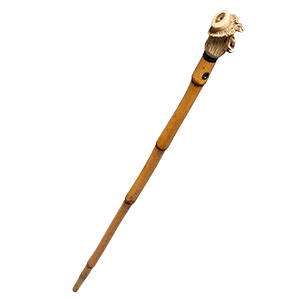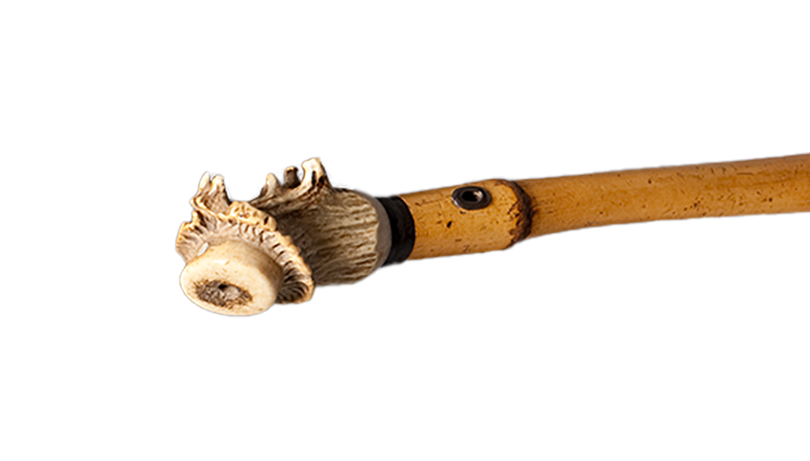 This bamboo cane, inscribed with Benjamin Franklin’s family motto Exemplum adest ipse homo (“Conduct marks the man”), is an unusual amalgamation of materials derived from hunted animals. The handle is thought to be staghorn, patterned with natural ridges and displaying a cross-section of bone as if severed at the antler. The other animal component is not a physical piece of a creature, but materially connected to the processes that would have transformed freshly killed fish and birds into a hungry shipman’s meal: cooking oil, which was once lodged in the cane’s hollow joint and may still linger in the object to this day.
This bamboo cane, inscribed with Benjamin Franklin’s family motto Exemplum adest ipse homo (“Conduct marks the man”), is an unusual amalgamation of materials derived from hunted animals. The handle is thought to be staghorn, patterned with natural ridges and displaying a cross-section of bone as if severed at the antler. The other animal component is not a physical piece of a creature, but materially connected to the processes that would have transformed freshly killed fish and birds into a hungry shipman’s meal: cooking oil, which was once lodged in the cane’s hollow joint and may still linger in the object to this day.
While at sea in 1757, Franklin took particular interest in a stark difference between the wakes of certain ships compared to others. Franklin consulted his captain and learned that one ship’s cook threw refuse oil over the side of the boat, turning the water tranquil—a phenomenon he had likewise learned about in his youth from the writings of Pliny, the ancient natural historian. It was at sea that Franklin fully contemplated “the wonderful Quietness of Oil on agitated water,” as cooks dumped excess oil into the ocean to settle anything from gentle rocking to violent waves—hence the idiom “to pour oil on troubled waters.” Franklin began to conduct experiments of oil’s effect on turbulent water, filling a small compartment in his cane with the oil and releasing it for observation.
From speaking with “an old Sea Captain, then a Passenger with [Franklin]” on another maritime voyage in 1762, he learned that the technique had completely different connections to food among enslaved populations in the Americas: namely, smoothing water with oil was a “practice of the Bermudians when they would strike Fish which they could not see if the surface of the Water was ruffled by the Wind.” Divers in the Mediterranean likewise released small quantities of oil that they stored in their mouths, for “when under Water in their Business, [they] need Light, which the curling of the Surface interrupts, by the refractions of so many little Waves.” The oil from these submarine mouths calmed the water’s surface “and permit[ted] the Light to come down to them.” Of all the technique’s permutations, Franklin wrote: “The Learned too, are apt to slight too much the Knowledge of the Vulgar.”

With cane in hand, Franklin made a habit of practicing his experiment and showing interested colleagues how oil could turn water “as smooth as a Looking Glass.” When it occurred to Franklin to play with the substance, oil suddenly transcended utility: it became a material used for experimentation—and, though Franklin made serious scientific observations, an object of recreational pleasure.
The cane is held by the American Philosophical Society, which was the first lasting scientific society in the United States—and was co-founded by Franklin himself. While the cane does not initially appear as a food object, it in fact preserves hidden connections between science and food through oil, a vibrant substance turned from mere cooking residue to an asset for sailors and fishers alike.
Image: Oil-Filled Cane. Bamboo, staghorn or bone, and metal. American Philosophical Society, eighteenth century (2009.24). Gift of H. H. Harjes, 1915.
 This article was written by C.C. Lucas. For more information about her work and her other contributions to The Kitchen in the Cabinet click here.
This article was written by C.C. Lucas. For more information about her work and her other contributions to The Kitchen in the Cabinet click here.
References
Boldt, Janine Yorimoto. Dr. Franklin, Citizen Scientist, with contributions by Emily A. Margolis. Philadelphia: American Philosophical Society, 2021.
Dawson, Kevin. “Enslaved Swimmers and Divers in the Atlantic World.” The Journal of American History 92, no. 4 (2006): 1327–1355.
Franklin, Benjamin. “Extract of a Letter from Benjamin Franklin LLD. and F R.S. to William Brownrigg M.D. and F.R.S. concerning the stilling of the Waves by means of Oil.” Franklin Papers. Nov. 7, 1773. https://franklinpapers.org/framedVolumes.jsp.
Warsh, Molly A. “A Political Ecology in the Early Spanish Caribbean.” The William and Mary Quarterly 71, no. 4 (2014): 517–548.